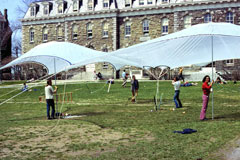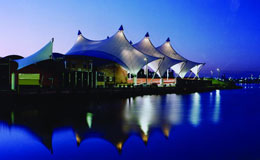A trio of alums were in the vanguard of fabric architecture
A trio of alums were in the vanguard of fabric architecture
It was a riot so raucous that it got rock concerts banned from Schoellkopf Field for forty years and counting. In 1972, Deep Purple was scheduled to headline what was supposed to be the first in a series of summer concerts. ZZ Top had played its opening set, but when it came time for the main act, one of the Deep Purple members—freaked out by a nearby lightning strike—refused to perform on the metal-and-fabric stage. With power cut to the PA system, organizers couldn't communicate with the audience. Their fury fueled by ample libations and assorted chemical substances, they tossed bottles, rushed the stage, even trashed a Steinway piano.
Then came the waterbed tsunami.
Because the stadium has artificial turf, the tentlike performance structure couldn't be staked to the ground. So the designers—architecture students Todd Dalland '73, BArch '77; Nicholas Goldsmith '74, BArch '75; and Denis Hector '74, BArch '76—had used thirty waterbeds as ballast. When the concert was cancelled, audience members sliced the beds open, unleashing a pressurized stream that Goldsmith compares to the Trevi Fountain. "We thought it was going to be a Woodstock," he says of the concert, "but it turned out to be more of an Altamont."

But here's the amazing thing: through it all, the tent stayed standing. And its designers went on to work together in a firm, called FTL, that has created hundreds of tentlike buildings—known as tensioned membrane structures—around the world. They range from an aviary at the Bronx Zoo to exhibition spaces for New York's Fashion Week to a Ringling Brothers' traveling circus tent to an acoustical shell for the National Symphony Orchestra in Washington, D.C. "I think as forms they're incredibly compelling—they're seductive and highly sculptural," says Hector, who left FTL for academia after several years and is now on the architecture faculty at the University of Miami. "Like a soap bubble, a tensile structure has its own shape—a balance of the tensions in the different directions. Normally in architecture, designers create a form and then engineers figure out how to make it. This is a far more intensely disciplined area of design, in which the form is dictated by the forces."

Among FTL's most widely celebrated projects was a traveling pavilion it designed for the Metropolitan Opera and the New York Philharmonic in the early Nineties. Carried on a fleet of trucks—which expanded hydraulically, like "Transformers" toys, to become the support structure—it migrated from park to park hosting summer performances for more than a decade. At the 1996 Olympic Games in Atlanta, FTL (the firm was originally called Future Tents Limited, but switched to the acronym when it expanded into other areas) served as the project architects for the twenty-one-acre Centennial Park. Its centerpiece was the AT&T Global Olympic Village, a 9,000-square-foot facility that featured NBC's broadcast studios, a media center, an athletes' village, and more. "One of the things that fascinated me about this type of architecture was that it has a very small footprint on the ground," Goldsmith says. "These are lightweight structures that can be set up relatively easily—they don't require a huge construction site—and once they're no longer needed they can be folded and moved away." They're also recyclable: trusses from a theater that FTL designed for a millennium event in London were repurposed for a Victoria's Secret fashion show in Miami Beach. "That's an interesting thing—that buildings don't have to be purpose-built with all new materials," he says, "and after their lifespan you can put them back on the shelf."
Dalland, Hector, and Goldsmith became enraptured with tensioned membrane structures after seeing a Museum of Modern Art exhibit on Frei Otto, the German architect considered the father of the field. It was the heady days of the counterculture—summer 1971—and Otto's work fit with the times, along with such influences as the Whole Earth Catalog and the work of R. Buckminster Fuller, creator of the geodesic dome. "We were exploring alternatives in society—alternative materials, more transient buildings, more transient lifestyles" says Dalland. "We were eschewing the traditions and the norms, or re-evaluating them." Designing tensile structures, he says, "was kind of an underground movement, like running away with the architectural circus."

The trio found an ally in a newly minted visiting assistant professor: Kent Hubbell '69. "I remember them coming to my office, pulling these little plastic tent models out of their pockets and putting them on my desk," says Hubbell, now Cornell's dean of students. With his blessing, the students not only designed such structures—some with tentlike frames and stretched material, others held up by being inflated—they actually built them. "It was a bit radical," Hubbell says. "You could go down to Agway and get a roll of polyethylene and some duct tape and put together an inflatable on the Arts Quad—which we did over and over again."
It was a more innocent age—or at least one less beset by liability concerns and helicopter parenting. "We built stuff all over the place," Hubbell recalls. "I built a big tensile structure behind Risley that was used as an events tent." As Hector puts it: "Most architectural education is a lot of drawing and imagining what it would be like. It was exciting to design something and actually put it up and see it." In addition to the stage for the now-infamous Deep Purple concert, the trio designed the venue for a spring arts festival on the Arts Quad—an event, they happily admit, they concocted so they'd have an excuse to build a home for it. "We basically created a little cell in the Architecture school," Dalland says. "We got our formalist indoctrination during the day, and after hours we pursued Frei Otto as the future of architecture."

After graduation, Dalland and his brother formed FTL and were later joined by Goldsmith and Hector, who'd been working for Otto in Germany. By 1995—when Dalland and Goldsmith were featured on the cover of Interiors magazine—the firm had received some 800 commissions and more than thirty awards. In 1996, Academy Editions published a 128-page monograph chronicling the firm's first two decades. "Anyone who wants a lightweight, membrane structure, who has a need for a flexible deployable shelter, who understands the favorable economics of building with tensile technology, automatically turns to FTL," said Interiors. "The firm has virtually no competition—simply because few designers have their know-how."
More competitors have since entered the market, says Dalland, who eventually left the firm to concentrate on combining membrane structures with solar power technology. "At the beginning it was new, it was fresh, it was unexplored," he says. "After thirty years of doing it, it became mainstream. It's a tiny part of the mainstream—but there are thirty companies in the U.S. now bidding on tensile structures, and 300 around the world."
Last year Dalland co-founded Pvilion, a firm that designs and manufactures electric vehicle charging stations using tensioned flexible solar panels; a prototype is now up and running outside Austin, Texas. Goldsmith remains FTL's senior principal, while Hubbell has continued to pursue fabric architecture both academically and professionally. "There's a real mythology associated with these kinds of structures; they have an intrinsically festive and ephemeral character," Hubbell says. "There's a long and interesting history of tents, from Genghis Khan to traveling circuses."


